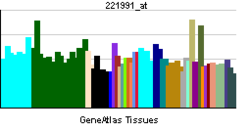- NXPH3
-
Neurexophilin 3 Identifiers Symbols NXPH3; NPH3 External IDs OMIM: 604636 MGI: 1336188 HomoloGene: 5227 GeneCards: NXPH3 Gene Gene Ontology Molecular function • molecular_function
• receptor binding
• protein bindingCellular component • extracellular region Biological process • neuropeptide signaling pathway Sources: Amigo / QuickGO RNA expression pattern 
More reference expression data Orthologs Species Human Mouse Entrez 11248 104079 Ensembl ENSG00000182575 ENSMUSG00000046719 UniProt O95157 Q5ST06 RefSeq (mRNA) NM_007225 NM_130858.3 RefSeq (protein) NP_009156 NP_570928.1 Location (UCSC) Chr 17:
47.65 – 47.66 MbChr 11:
95.37 – 95.38 MbPubMed search [1] [2] Neurexophilin-3 is a protein that in humans is encoded by the NXPH3 gene.[1][2]
References
- ^ Missler M, Sudhof TC (Jun 1998). "Neurexophilins form a conserved family of neuropeptide-like glycoproteins". J Neurosci 18 (10): 3630–8. PMID 9570794.
- ^ "Entrez Gene: NXPH3 neurexophilin 3". http://www.ncbi.nlm.nih.gov/sites/entrez?Db=gene&Cmd=ShowDetailView&TermToSearch=11248.
Further reading
- Gerhard DS, Wagner L, Feingold EA, et al. (2004). "The status, quality, and expansion of the NIH full-length cDNA project: the Mammalian Gene Collection (MGC).". Genome Res. 14 (10B): 2121–7. doi:10.1101/gr.2596504. PMC 528928. PMID 15489334. http://www.pubmedcentral.nih.gov/articlerender.fcgi?tool=pmcentrez&artid=528928.
- Zhang Z, Henzel WJ (2005). "Signal peptide prediction based on analysis of experimentally verified cleavage sites.". Protein Sci. 13 (10): 2819–24. doi:10.1110/ps.04682504. PMC 2286551. PMID 15340161. http://www.pubmedcentral.nih.gov/articlerender.fcgi?tool=pmcentrez&artid=2286551.
- Clark HF, Gurney AL, Abaya E, et al. (2003). "The secreted protein discovery initiative (SPDI), a large-scale effort to identify novel human secreted and transmembrane proteins: a bioinformatics assessment.". Genome Res. 13 (10): 2265–70. doi:10.1101/gr.1293003. PMC 403697. PMID 12975309. http://www.pubmedcentral.nih.gov/articlerender.fcgi?tool=pmcentrez&artid=403697.
- Strausberg RL, Feingold EA, Grouse LH, et al. (2003). "Generation and initial analysis of more than 15,000 full-length human and mouse cDNA sequences.". Proc. Natl. Acad. Sci. U.S.A. 99 (26): 16899–903. doi:10.1073/pnas.242603899. PMC 139241. PMID 12477932. http://www.pubmedcentral.nih.gov/articlerender.fcgi?tool=pmcentrez&artid=139241.
- Hirosawa M, Nagase T, Ishikawa K, et al. (2000). "Characterization of cDNA clones selected by the GeneMark analysis from size-fractionated cDNA libraries from human brain.". DNA Res. 6 (5): 329–36. doi:10.1093/dnares/6.5.329. PMID 10574461.
- Missler M, Hammer RE, Südhof TC (1999). "Neurexophilin binding to alpha-neurexins. A single LNS domain functions as an independently folding ligand-binding unit.". J. Biol. Chem. 273 (52): 34716–23. doi:10.1074/jbc.273.52.34716. PMID 9856994.
- Petrenko AG, Ullrich B, Missler M, et al. (1996). "Structure and evolution of neurexophilin.". J. Neurosci. 16 (14): 4360–9. PMID 8699246.
Categories:- Human proteins
- Chromosome 17 gene stubs
Wikimedia Foundation. 2010.
